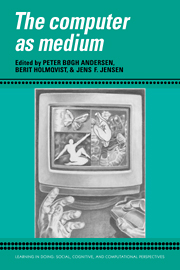Book contents
- Frontmatter
- Contents
- Series foreword
- Preface
- Contributors
- Part I Computer-based signs
- Introduction
- 1 A semiotic approach to programming
- 2 Structuralism, computation, and cognition: The contribution of glossematics
- 3 The shortest way between two points is a good idea: Signs, Peirce, and theorematic machines
- 4 Logic grammar and the triadic sign relation
- 5 Meaning and the machine: Toward a semiotics of interaction
- Part II The rhetoric of interactive media
- Part III Computers in context
- Index
4 - Logic grammar and the triadic sign relation
Published online by Cambridge University Press: 05 October 2010
- Frontmatter
- Contents
- Series foreword
- Preface
- Contributors
- Part I Computer-based signs
- Introduction
- 1 A semiotic approach to programming
- 2 Structuralism, computation, and cognition: The contribution of glossematics
- 3 The shortest way between two points is a good idea: Signs, Peirce, and theorematic machines
- 4 Logic grammar and the triadic sign relation
- 5 Meaning and the machine: Toward a semiotics of interaction
- Part II The rhetoric of interactive media
- Part III Computers in context
- Index
Summary
The tradition of analytical semiotics initiated by C. S. Peirce is often thought of as being in some sense contrary to formal logic. This is especially so, when formal logic is associated with the classical correspondence theory of truth as in the project of formal semantics for natural language. However, the perceived opposition between the two traditions has become dubious since the advent of logic grammar, which came mainly from the works of Richard Montague in the late 1960s.
Logic grammar differs from philosophical logic first and foremost by specifying a translation procedure from natural language into formal logic. It is true, of course, that the very idea of representing the meaning of natural language sentences by logical forms has been prominent in philosophical logic and analytical philosophy throughout our century. One particularly famous example is Bertrand Russell's discussion of “definite descriptions” (Russell, 1905), and his suggestion of representing sentences containing definite descriptions by a certain type of logical forms. For instance, the sentence
(1) “The present King of France is bald” should be represented as
(2) ∃! x. King-of-France(x) ∧ bald(x)
where (2) may be read as “there exists one and only one object, which is king of France, and which is bald.” Russell considered the sentence (1) to be false if uttered in our time (or 1905); the transcription of (1) into (2) would serve as a formal explanation of the falsehood of (1). It should be noted, however, that in philosophical logic formal representations are simply stipulated for the purposes of whichever discussion is going on.
Information
- Type
- Chapter
- Information
- The Computer as Medium , pp. 104 - 127Publisher: Cambridge University PressPrint publication year: 1994
